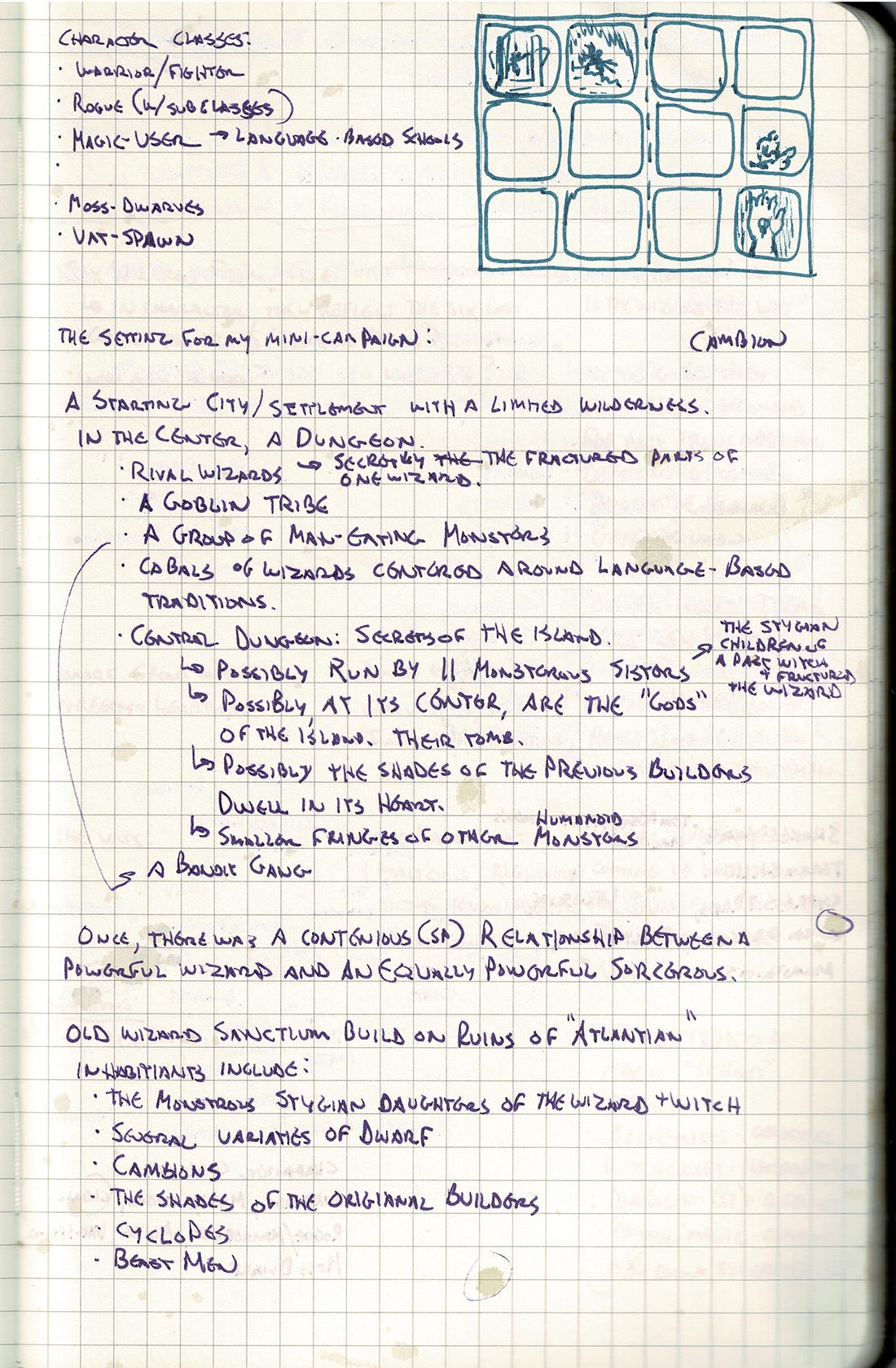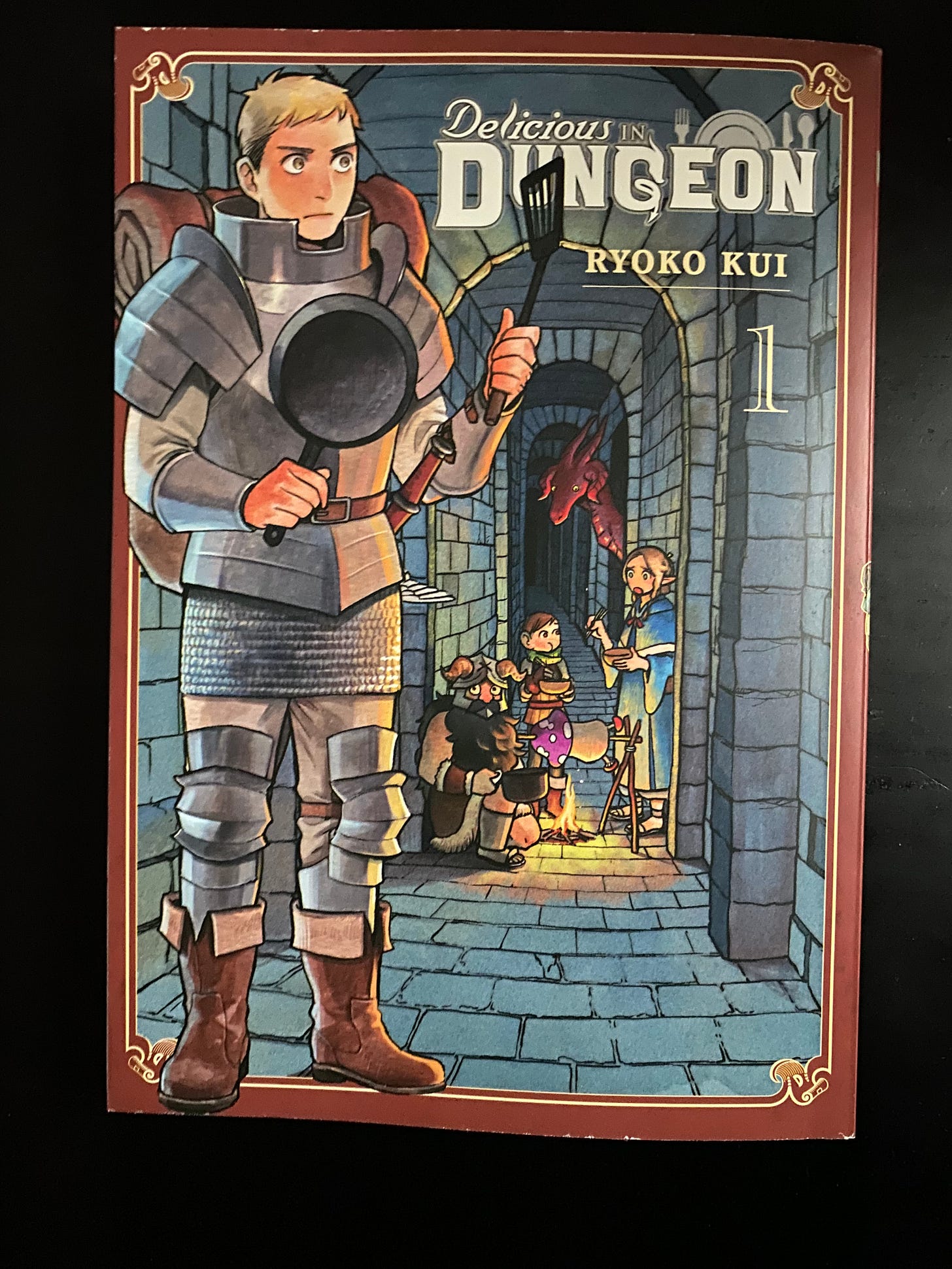Memories of Cuccagna
More Scans from What Fools These Adventures Be and a Quick Look at Delicious In Dungeon

When I was pulling my installment on my previous campaign What Fools These Adventurers Be together, I ended up with all sorts of ephemera I wanted to include but I didn’t have space. I still want to share some of them. While they didn’t fit either subject matter of the previous writing exploring that campaign, I feel they are great glimpses into the process of developing the game.
Warts and all, here is the character sheet I used for What Fools These Adventures Be. It is riddled with spelling mistakes that I fixed with paste-ups on a copy made from this original in my sketch book. I used OD&D as the spine of the rule set for the campaign but modified it to my own tastes. The biggest chances not derived from the original three little brown books or their supplements were are follows:
Ascending Armor Class and to-hit bonuses instead of attack matrices
A D6 system for any special skills (though the campaign didn’t have thieves)
The Wonder & Wickness spell system for magic-users while elves used a more traditional fire-and-forget system.
In addition, a few other features that might seem like just color were added in the upper right portion of the character sheet. In fact, several of these deeper importance mechanically and in play. One of them was “Nation of Origin”. The players randomly rolled for their home nation (all nonexistent realms from Europe myth): Cuccagna, Lyonese, Thule, and Ys. I hunted for a North African-fabled locale, which I feel is quintessential to that Mediterranean vibe, but had no luck. Outside of determining a PC’s starting languages, the nation of origin also opened up access to a “Background” subtable for each place. Those origins also created some initial bonds between characters that the players seized on all on their own. A core of adventurers from Ys drove a lot of the action for awhile.
Two more elements of note lived in that portion of the character sheet: “love interest” and “heir”. “Love Interest” was a mechanic not normally found in D&D but felt essential to the Shakespearean-roots of the setting. Based on a frame for potential romantic interests that the player was comfortable with for their PC, a Charisma-based roll was made to see if a PC would fall in love with encountered NPCs when the NPC was someone the player character would be attracted to. The fated and often star crossed results had an out-of-the-character’s control element that seemed key to capturing the Shakespearean inspiration for the setting. As for the “heir”, it was a porting over of my favorite but often overlooked B/X rule of once a campaign, a player designating an heir to a character to receive a portion of the character’s stuff when they die.

The character sheet was actually one of the last things I made before I started running the game. Next, let’s look at the very first page I wrote.
In this scan of my very first notes for the campaign, you can see that I hadn’t even 100% committed to using the Cuccagna setting yet. The spirit of the setting, though, is everywhere in the description of this “mini-campaign”. I tackled building the setting by making a list of potential PC classes, a quick description of what I wanted outside the dungeon, a loose frame for the dungeon, humanoid monsters I was thinking about for main factions, and a few relations between some of them.
This next section of notes is not literally next page I did but it is close. I made a little map of the first five levels from a wizard’s sanctorum down to a water-filled cave with a black, sandy beach where a gate to Hell sat. It included a more focused set of notes about what monsters I would like on what levels. I also spent some time at the top looking at my first few levels tracking my placement of monsters, tricks & traps, stand alone treasure, monsters with treasure, and “empty” rooms. These placements were compared to the suggestions in original D&D books as well as the treasure breakdown in some favorite adventures like Into The Unknown.
For the inhabitants of the dungeon, I was digging through OD&D monster lists to see what would fit the vibe of the setting. That included mostly drawing from creatures found in myth and legend. In addition, I was thinking about adding some non-traditional D&D creatures like non-goblin hobs, a trio of powerful witches I called “The Sisters”, beastmen, undead “shades”, and vat spawned beings inspired by Jack Vance stories and this post by Jeremy Duncan.
Above is another side view. Looking through my notes, I drew a lot of maps like these but thought it best to not blast you all with a myriad of only slightly different variations on the same underground complex. I feel like when this map is compared to others in this post and in my last e-mail, the evolution of the dungeon is still shown. Major factions/themes have been established by this point. I possess a more concrete idea of spatial relationships between levels as well.
This partial scan is of the rumor table used at the start of the campaign. Every starting player got one free throw on the table at the time of character generation.
Here is a rival adventuring party (inspired by one of the parties of rival adventurers from this Middenmurk post) that I approached mostly through drawing rather than writing. Outside of a rough illustration for each member, I broke them down by name with numerical values just for HP, AC, and weapon damage. As you can see, I used this spread in my sketchbook to run and track encounters players had with this group of listless former Crusaders. Eventually, through a few turns of fate, Lorenzo on the far right there became a replacement PC.
I will end with a sketch of another NPC that became an player character. Jacquenette started out as a pilgrim at the Abbey of St. Gambrinus who became a retainer to escape her lecherous traveling companions (in the spirit of Shakespearean comedies and Chaucer). After the death of her magic-user employer, she took over his spell book to last as a PC through the end of the campaign.
Delicious In Dungeon/Dungeon Meshi
For a while now, Skullboy has been recommending I read Delicious In Dungeon (originally called Dungeon Meshi) by Ryoko Kui. Contrary to him playing a dwarfin dungeon chef for years, he discovered the series just earlier in 2023. The manga had been on my radar for a bit but I had been able to resist its premise of cooking one’s way through a dungeon delve. I have made a choice to avoid any new dungeon-based comics due to me working on my comics zine series Underworld Adventure. Skullboy finally hooked me into giving it a read in spite of this when he responded in my Twilight Age Discord to another player posting the anime trailer with this:
“honestly I think its a must for anyone playing or running a west marches game”
I am only one volume in but I can see why Skullboy believes this about the series. There is a real dearth of fiction about megadungeon-like settings. With it being a setting that many find hard to understand and pushes their suspension of disbelief when they encounter the idea, having examples to point to that ground what seems like a very gamified space is indispensable. I know for me, reading Margaret St. Clair’s Sign of the Labrys really helped me grasp the idea of the megadungeon.
So far, Delicious In Dungeon delivers on this front in spades. The overall a megadungeon is given a clear gimmick for its existence. Connections between levels are shown. Readers get glimpses of the culture around adventuring in such a structure. Where Ryoko’s work really sings is in his approach to dungeon ecology. Through focusing on dungeon denizens as food, she creates a vivid world that firmly places creatures in the space of the dungeon along with displaying how monsters coexist.
Such a fleshed up large underworld space is a true rarity. Even more so when it doesn’t exist in a mythic or dream-like space. Ryoko’s work does draw a lot from vanilla fantasy and video game-style dungeoneering. These aesthetic touchstones will not be for everyone but Delicious In Dungeon is well worth checking out even if the series is not quiet your vibe. Even a short visit to Ryoko Kuo’s world gives readers insights into what megadungeons are like.
Due to some health biz caused by working at computers too much, I envision that this newsletter will keep its twice-a-month pace for awhile. Next time, I plan on digging into how I set about designing the Twilight Age as a megadungeon game to last as well as looking at some of the elements I first started thinking about building the campaign. See you all soon!












I always liked the idea of love interests for player characters, but have always struggled with how to include something like that in a game. Years ago I too wrote up a percent chance table to see if a PC felt "love/crush at first sight" whenever they met a new NPC. I envisioned it as a way for players to dig in and role play a bit more if they wanted. Having a "love interest" section on the character sheet sounds like it might help players think that it could be fun and useful to actually engage.
Too bad Scamandros got zapped away before I could follow up on anything with him! Maybe we'll figure out a way to reincorporate him